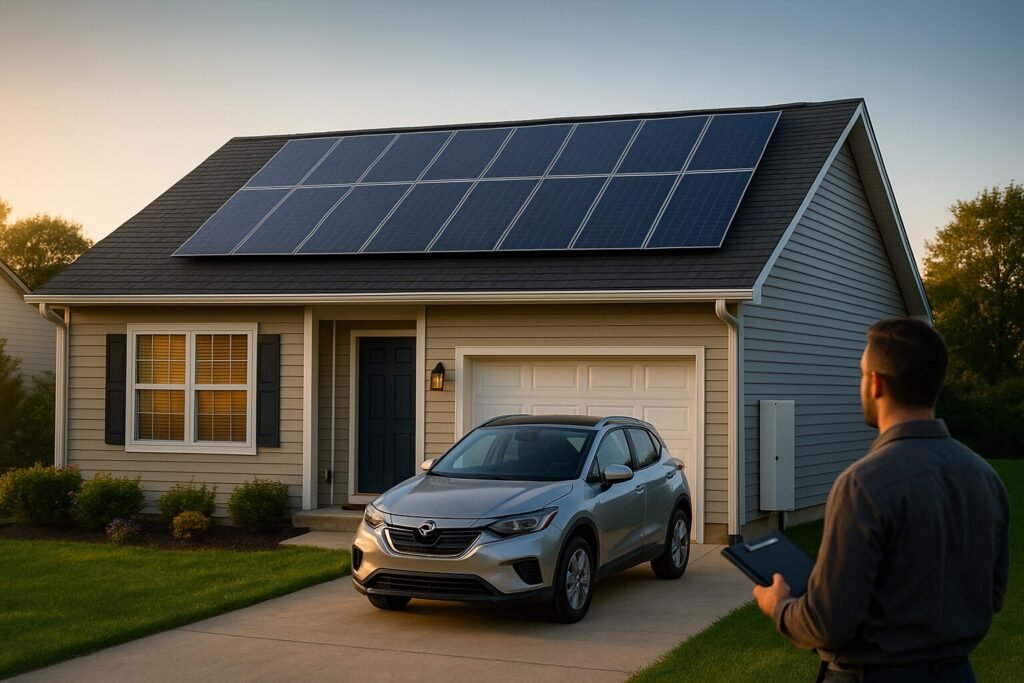Solar Panel Cost 2025: Real Prices, Payback & Savings
2025 solar costs explained: $/W ranges, ITC math, local incentives, battery adders, ROI, and soft-cost tricks—clear steps to get your best quote.
I remember the first time I priced out solar for my little homestead project. I thought the “panel price” was the price. Nope. In 2025, the total installed cost is a mix of hardware, design, permits, labor, financing fees, and (if you want backup) batteries. This guide walks you through what people actually pay this year, how the 30% tax credit works, why quotes vary, and how to get your best price without headaches.
TL;DR Snapshot (for skimmers)
- Typical installed price (before incentives): roughly $2.5–$3.4 per watt (Wdc), depending on region, equipment, and financing. A 6–10 kW system lands near $15k–$34k before incentives. seia.org+1
- 30% federal credit: still the big lever in 2025; confirm the latest rules before you file. irs.gov
- Batteries: great for outages/TOU rates; they add meaningful cost—decide with data, not vibes.
- Biggest swing factors: equipment choices, roof complexity, soft costs (permitting/sales/financing), and your export/buyback rate.
- Payback & ROI: fastest in high-rate areas or with smart self-consumption + batteries (when export rates are low).
Skim-Stopper: Your 60-Second Cost Estimator
Grab your last 12 months of kWh.
- Size the array (quick rule-of-thumb): annual kWh ÷ 1,300–1,500 ≈ system kW (Northern states use ~1,300; sunny Southwest can use ~1,500).
- Estimate pre-credit cost: kW × $2.6–$3.3/W × 1,000.
- Estimate post-credit: subtract 30% of eligible costs (labor, equipment, permits, sales tax in many places).
- Sanity-check: run your address through PVWatts to confirm production and recalibrate sizing. pvwatts.nrel.gov
1) 2025 Cost Basics: Cost-Per-Watt and by System Size
Cost per watt (Wdc) is how most residential quotes are compared. In 2025, national data points show a wide range because markets and incentives vary:
- SEIA/WoodMac: residential prices in Q1 2025 averaged ~$3.36/Wdc (up ~3% YoY). seia.org
- Marketplaces still report many installs near the mid-$2s per watt (especially straightforward roofs and cash deals). energysage.com
Example ranges (illustrative, before incentives):
| System size | Low ($2.5/W) | Mid ($2.9/W) | High ($3.4/W) |
|---|---|---|---|
| 4 kW | $10,000 | $11,600 | $13,600 |
| 6 kW | $15,000 | $17,400 | $20,400 |
| 8 kW | $20,000 | $23,200 | $27,200 |
| 10 kW | $25,000 | $29,000 | $34,000 |
Why such a spread? Roof complexity, equipment (string vs. microinverters; premium vs. value modules), soft costs, and financing dealer fees.
2) The 30% Federal Tax Credit (ITC): What You Actually Pay
The Residential Clean Energy Credit lets you claim 30% of eligible project costs for systems placed in service in the qualifying period (equipment + labor + permitting + certain adders). Check IRS Form 5695 and instructions; battery storage ≥3 kWh is also explicitly supported. irs.gov+1
Quick math: If your all-in cost is $24,000, then 30% = $7,200. Your net out-of-pocket (after credit) is $16,800. If your tax liability is smaller than the credit, you can typically carry forward the remainder (see the current IRS instructions).
2025 policy watch: Late-2025 reporting raised uncertainty about future credit timing. Use IRS guidance when you file and confirm with a tax pro; some outlets reported end-of-year changes, but the IRS page (updated July 2025) still states 30% through 2032 at the time of writing. irs.gov+1
3) State/Utility Incentives & Net-Metering/Buyback Rates (2025)
After the federal credit, state/utility incentives, and export/buyback rules, move your payback the most. Start with DSIRE, then check your utility’s tariff. Many markets have shifted from classic net metering to net billing with export rates lower than retail—this changes the math and often nudges you toward self-consumption (run loads when the sun’s out or add batteries). dsireusa.org
4) 2025 vs. 2024: Did Prices Rise or Fall—And Why?
- Equipment: Module prices hit historic lows in 2024, then bounced around in 2025; spot benchmarks for n-type TOPCon around ~$0.088/W (FOB China) help explain why hardware can be cheap while installs aren’t. pv magazine International
- Soft costs & financing: Permitting, inspections, customer acquisition, and dealer fees are a large slice of residential pricing.
- Market dynamics: Some reports show record-low quotes in 2024, with 2025 seeing modest upticks in certain quarters (labor, financing, policy shifts). energysage.com+1
5) Payback Period & ROI at 2025 Electricity Rates
Here’s how I explain it to friends:
- Annual savings ≈ (kWh you avoid buying × your retail rate) + (credits for exports at your buyback/export rate).
- Payback (yrs) ≈ net cost after credit ÷ year-1 savings.
- Adjust for rate inflation and a small degradation (panels lose ~0.25–0.7% per year, depending on model).
Rule-of-thumb:
- Low-rate markets (~$0.15/kWh): 10–14 years
- Mid-rate (~$0.25/kWh): 7–10 years
- High-rate (≥$0.35/kWh): 4–7 years
Smart load-shifting and batteries can improve ROI where export rates are weak.
6) Equipment Choices That Move the Quote
A) Inverters: String vs. Microinverters (and DC Optimizers)
- String inverters: Usually the lowest cost; best on simple, unshaded roofs.
- Microinverters/Optimizers: Add granular monitoring and shade resilience; expect a higher $/W but better production on tricky roofs and complex layouts.
B) Mounting: Roof vs. Ground Mount
- Roof: Lowest labor and trenching.
- Ground mount: More steel, concrete, trenching, and sometimes engineering—often +$/W but great orientation/tilt and easier cleaning.
C) Panels: Premium vs. Value
- Premium modules (n-type, higher efficiency, longer warranties) can nudge price up but shrink array footprint, which helps on tight roofs.
Helpful internal reads:
7) Batteries in 2025: How Much They Add—And When They Pencil Out
Batteries shine for blackouts, time-of-use arbitrage, and self-consumption where export rates are low. Expect a noticeable adder for 10–20 kWh of usable storage (equipment + labor + commissioning). The 30% federal credit applies to qualifying battery systems (≥3 kWh). Confirm with Form 5695 and current IRS guidance. irs.gov+1
When they make sense:
- Frequent outages or critical loads to protect
- TOU plans with high on-peak rates
- Markets with export limits or low daytime buyback
8) Lease, PPA, Loan, or Cash (Lifetime Cost in 2025)
- Cash: Lowest lifetime cost; highest upfront.
- Loan: Watch APR, term, and dealer fees; the wrong combo can add $0.30–$0.80/W (sometimes more).
- Lease/PPA: Often $0-down and simple; check escalators, term, buyout, home sale transfer, and production guarantees.
Template to compare apples-to-apples: Put each bid’s total paid over 20–25 years next to a no-solar baseline (utility bills), then pick the clear winner.
9) Soft Costs in 2025—And How to Lower Them
Soft costs (design, permits, inspections, interconnection, sales, financing) are the big unlock. Jurisdictions that adopt SolarAPP+ can cut review times from weeks to near-instant, which reduces installer carrying costs and, over time, consumer pricing. Ask if your city supports it. NREL
My quick wins:
- Request your AHJ’s exact submittal checklist up front.
- Provide a clean roof plan, equipment cut sheets, and a one-line diagram.
- Ask installers to itemize dealer fees and soft-cost line items.
- If reroofing soon, bundle reroof + solar to avoid double labor.
10) “Surprise” Adders: Main-Panel Upgrades, Roof Work, Trenching
- Main-panel upgrade (MPU): Needed if bus rating/backfeed rules are tight; price it upfront.
- Reroof/structural: If your roof is near end-of-life, replace it before solar.
- Ground mounts: Footings, posts, trenching, and longer conduit runs add cost—worth it for perfect tilt/azimuth.
11) Owning the System: Ongoing & Long-Term Costs
- Monitoring: Many systems include it; some platforms offer paid tiers.
- Maintenance: Occasional cleaning where dusty/salty; annual visual checks for critter damage and loose conduit.
- Replacements: Inverters (10–15 yrs typical), batteries (cycle-dependent).
- O&M: Industry references put routine O&M at a modest annual figure for residential (varies with site/equipment). atb.nrel.gov
Regional Snapshots (Quick Ideas)
- High-rate states: Faster payback; even export-limited markets can win with load shifting or battery.
- Hot climates: Mind temperature coefficients; spacing for airflow helps.
- Snowy regions: Lower winter sun; size for your worst month if you want high winter coverage.
Real-World Quote Walkthrough (Use This Checklist)
- Ask for matching specs across bids (system kWdc, panel/inverter model, racking, monitoring, battery kWh).
- Demand line-item dealer fees and all adders (MPU, trenching, reroof).
- Compare lifetime cost and production guarantees, not just the monthly payment.

Step-by-Step: Get Your Best Price in 5 Moves
- Pull 12 months of bills; total the kWh.
- Run PVWatts and pick a target system size. pvwatts.nrel.gov
- Get 2–3 apples-to-apples quotes with identical specs.
- Verify federal + state/utility incentives and your export/buyback rate. dsireusa.org
- Choose the bid with the lowest lifetime cost and the clearest workmanship/warranty terms.
FAQs
Does the 30% credit stack with state rebates?
Generally, yes—state rebates usually reduce your project’s basis first, then you apply federal credit on the net. Confirm with a tax pro. irs.gov
Do standalone batteries qualify?
Yes, ≥3 kWh systems qualify under current IRS guidance. Use Form 5695. irs.gov
Why is U.S. rooftop solar still pricey if panels are cheap?
Because soft costs dominate residential installs, permitting, inspections, customer acquisition, and financing fees add up. SolarAPP+ and process discipline help. NREL
Key Takeaways
- Think in $/W and lifetime cost, not just monthly payments.
- The 30% federal credit plus local incentives still deliver a strong ROI for many homes—verify the latest rules before you sign. irs.gov+1
- Batteries are worth it for outages, TOU arbitrage, or weak export rates—run the numbers.
Resources (External)
- IRS Residential Clean Energy Credit (Form 5695 & guidance): irs.gov+1
- DSIRE incentive database (state/utility programs): dsireusa.org
- SEIA/WoodMac Solar Market Insight (pricing trends): seia.org
- NREL PVWatts (production estimates): pvwatts.nrel.gov
- Module price context (n-type TOPCon): pv magazine International
